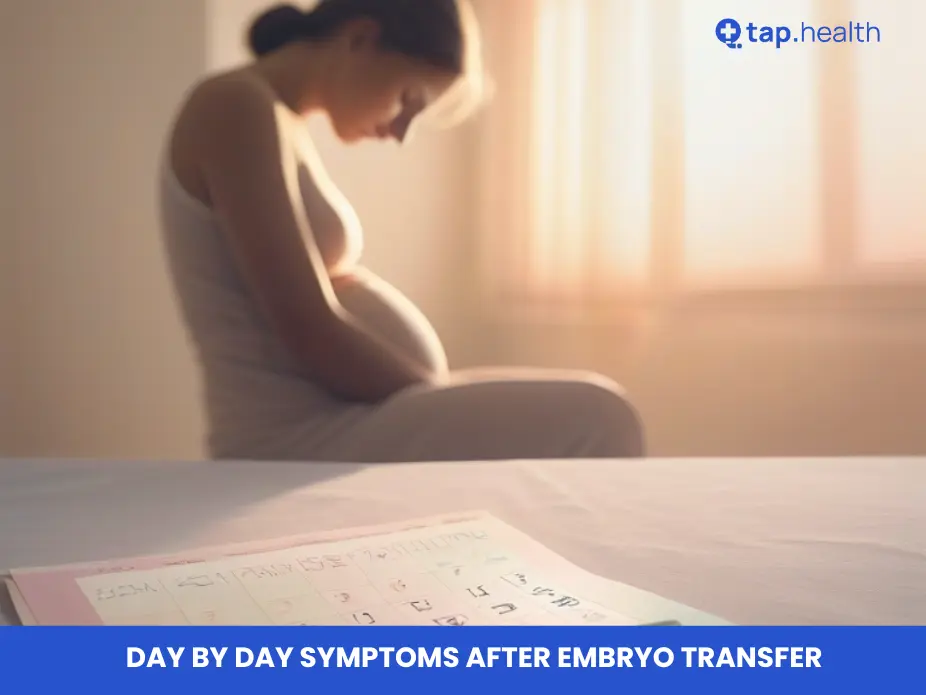Embarking on the path of embryo transfer is an important moment for people doing in vitro fertilization (IVF). This procedure is a key step in the emotional journey of fertility treatments. It is very important to understand the details of embryo transfer. This includes knowing the IVF process and the differences between fresh and frozen transfers. After the transfer, pay attention to any small symptoms and changes in your body. These can help you figure out if you might have a successful pregnancy.
what is Embryo Transfer in IVF
Embryo transfer in IVF is an important step. In this procedure, doctors place fertilized eggs into a woman’s uterus to help her become pregnant. This usually happens after ovarian stimulation and egg retrieval. The goal is to make sure the embryos attach well to the uterine lining so a healthy pregnancy can start. Things that can affect success rates include the number of embryos transferred, the quality of the embryos, and the overall health of the woman. Knowing about this stage is very important for people who are going through fertility treatments.
The Process of Embryo Transfer
During the embryo transfer, the fertility doctor uses a thin catheter. They carefully place the embryo into the woman’s uterus. This is often done with the help of an ultrasound. The ultrasound ensures that the embryo is positioned exactly right. The transfer usually happens three to five days after egg retrieval. This timing depends on how the embryo is developing. After the transfer, some women may need to rest for a little while. Then, they can go back to their normal activities. This step is very important in IVF treatment. It prepares for possible implantation and pregnancy.
Fresh vs. Frozen Transfers: What’s the Difference?
Fresh embryo transfers happen with embryos made in the same IVF cycle. Frozen transfers use embryos that have been frozen and saved for later use. Fresh transfers fit with the monthly menstrual cycle. On the other hand, frozen transfers give more flexible timing. This flexibility can lead to higher success rates for some patients.
Immediate Aftercare Post-Embryo Transfer
After the embryo transfer procedure, it’s very important to take care of yourself right away to help it succeed. After the transfer, try to keep your activities light. Avoid any tough exercises. It’s also critical to take your medications and supplements as directed to support the embryo that has been implanted. Good aftercare creates a good environment for the embryo implantation process and its growth. Watch for any unusual symptoms and follow your fertility doctor’s advice during this sensitive time after the transfer. Finding a good mix of rest and everyday activities will help the implantation process be healthy.
Activities and Restrictions
After an embryo transfer, you can usually walk, do light stretches, and carry out your normal daily tasks. But, try to avoid heavy lifting, tough workouts, and any stressful activities, as these can affect implantation. Stay away from hot baths, saunas, and swimming in pools to reduce the risk of infections. It’s important to avoid alcohol, tobacco, and caffeine. Drink enough water, but don’t overdo it. Make sure to follow your fertility doctor’s specific instructions for care after the transfer to help increase the chance of a successful implantation. Pay attention to how you feel and focus on resting and relaxing during this important time.
Medications and Supplements to Consider
Before embryo transfer, fertility clinics often give medications like progesterone. This helps support the uterine lining. They may also suggest supplements such as folic acid and prenatal vitamins. These are good for improving the chances of a successful pregnancy. The medications create a good environment for the embryo to implant and grow. It is very important to follow the prescribed dosage and timing closely. This helps get the best results. If you have any concerns or notice side effects, talk to your healthcare provider. This will help make the implantation process smooth and successful.
Day-by-Day Symptoms After Embryo Transfer
Understanding the timeline of symptoms can help you distinguish between normal post-transfer sensations and signs that might require medical attention.
Day 1-2: Resting Period
- What’s Happening: The embryo(s) is still in the process of “hatching” and begins to make its way toward the uterine lining. This stage is primarily about resting and allowing the body to adjust.
- Common Symptoms:
- Mild Cramping: Some women report feeling slight cramping similar to period pain, which can be attributed to the uterus adjusting to the embryo transfer.
- Spotting: Light spotting can occur due to the transfer procedure. This is usually not a cause for concern unless it becomes heavy.
- Bloating: Hormonal medications used during IVF can lead to bloating and a sense of fullness in the abdomen.
- Management Tips:
- Rest: It’s important to take it easy during the first couple of days. Avoid strenuous activities and heavy lifting.
- Hydration: Drink plenty of water to stay hydrated, which can also help reduce bloating.
Day 3-4: Early Implantation
- What’s Happening: Around this time, the embryo begins the process of implantation, where it attaches itself to the uterine lining. This is a critical stage in the IVF process.
- Common Symptoms:
- Implantation Cramps: Some women may experience mild cramping as the embryo implants. This is usually a good sign, indicating that the embryo is trying to attach to the uterine lining.
- Spotting: Light spotting or “implantation bleeding” may occur. It is typically light pink or brown and should not be heavy.
- Fatigue: The body is working hard to support the implantation, which may result in a feeling of tiredness.
- Management Tips:
- Relaxation: Continue to avoid heavy physical activity. Gentle walking and light stretching are okay.
- Nutrition: Eating a balanced diet rich in nutrients can help support your body during this critical phase.
Day 5-6: Continued Implantation
- What’s Happening: If the embryo successfully implants, it will start to produce the hormone hCG (human chorionic gonadotropin), which is what pregnancy tests detect. The uterine lining thickens to support the growing embryo.
- Common Symptoms:
- Increased Fatigue: Hormonal changes and the body’s increased demand for energy can cause a significant feeling of tiredness.
- Mild Nausea: Some women might start to experience early signs of nausea, though it is usually mild at this stage.
- Breast Tenderness: Hormonal changes may cause breast tenderness or swelling.
- Management Tips:
- Rest When Needed: Listen to your body and rest when you feel tired. Adequate sleep is crucial.
- Gentle Activity: Continue with light activities to keep your body moving without overexerting yourself.
Day 7-8: Early Pregnancy Symptoms
- What’s Happening: The embryo continues to grow, and if implantation was successful, hCG levels will start to rise, leading to more pronounced early pregnancy symptoms.
- Common Symptoms:
- Increased Nausea: As hCG levels increase, you may begin to experience more noticeable nausea, often referred to as “morning sickness,” though it can occur at any time of day.
- Mood Swings: Hormonal fluctuations can lead to mood swings, where you may feel emotional or irritable.
- Frequent Urination: The increasing levels of hCG and other hormones may cause you to urinate more frequently.
- Management Tips:
- Dietary Adjustments: Eating small, frequent meals can help manage nausea. Avoid spicy and greasy foods.
- Stay Hydrated: Continue to drink plenty of water, especially if you are experiencing nausea.
Day 9-10: The “Two-Week Wait” Anxiety
- What’s Happening: As you approach the end of the two-week wait, anxiety about the outcome can peak. The embryo is now fully implanted if the process has been successful.
- Common Symptoms:
- Anxiety: It’s common to feel anxious as the time for taking a pregnancy test draws near.
- Mixed Symptoms: Some women may experience fluctuating symptoms, such as on-and-off cramping, spotting, or nausea.
- Breast Changes: Continued tenderness, swelling, or changes in the appearance of your breasts may occur.
- Management Tips:
- Stress Management: Engage in stress-reducing activities such as meditation, deep breathing exercises, or light yoga.
- Support System: Lean on your support system, whether it’s your partner, friends, or a support group, to help manage the emotional toll.
Day 11-12: Preparing for the Pregnancy Test
- What’s Happening: By this time, hCG levels should be detectable by a blood test, and some women may begin to experience more pronounced pregnancy symptoms.
- Common Symptoms:
- Heightened Early Pregnancy Symptoms: Nausea, breast tenderness, and fatigue may become more noticeable.
- Spotting or Light Bleeding: Some women experience spotting or light bleeding around this time, which can be alarming. However, it does not necessarily indicate a problem.
- Mild Cramping: As the embryo grows and your body adjusts, you might feel mild cramping.
- Management Tips:
- Avoid Early Testing: Testing too early can lead to inaccurate results. Follow your doctor’s guidelines on when to test.
- Stay Positive: Try to remain positive and focus on taking care of yourself. The outcome is not something you can control at this point.
Day 13-14: The Pregnancy Test
- What’s Happening: The long-awaited pregnancy test day arrives. This can be done through a blood test at your clinic, which is the most accurate method.
- Common Symptoms:
- Test Anxiety: It’s natural to feel anxious or nervous about the result.
- Continued Early Pregnancy Symptoms: Symptoms like nausea, breast tenderness, and fatigue may continue.
- No Symptoms: It’s also possible not to feel any symptoms, which does not necessarily mean the transfer was unsuccessful.
- Management Tips:
- Take the Test: Follow your doctor’s instructions for taking the pregnancy test, usually done with a blood test for accurate results.
- Next Steps: Regardless of the outcome, have a plan for your next steps, whether it’s celebrating the positive result or discussing future options with your doctor.
Symptoms to Expect in the First Week
During the first week after embryo transfer, you might feel some early signs. These could include mild cramping or bloating, which are normal feelings after the procedure. This happens because the uterine lining adjusts to the transferred embryos. As the days go by, you may notice symptoms of implantation, such as light spotting or changes in your basal body temperature. These early symptoms may show that implantation is starting, suggesting a chance for early pregnancy. Pay attention to any physical symptoms you notice, as they might indicate the path toward a successful pregnancy.
Days 1-3: Initial Signs and Sensations
After embryo transfer, the first three days are very important for watching for early signs. You might feel light cramps or see some spotting, which can show that implantation is starting. Changes in hormones can cause mood swings and tiredness. Your body might also respond to the medications, leading to mild side effects. It is essential to pay close attention to your symptoms during this time. Keeping track of these early signs can help your healthcare provider have better information for the next steps in the IVF cycle.
Days 4-7: Implantation Symptoms
During days 4-7 after embryo transfer, you might start seeing some signs of implantation. Some women may notice light spotting. This is called implantation bleeding, and it happens as the fertilized egg sticks to the wall of the uterus. Cramping could also continue and might get a bit stronger as the embryo settles in. You may feel more intense emotions or mood swings because of hormonal changes. Breast tenderness might become more noticeable too. It’s important to watch for these signs since they could mean the implantation process is successful.
Recognizing Implantation Signs
Implantation signs can show up in different ways for each person. Common signs are spotting or light bleeding, which people might confuse with the start of their menstrual cycle. Cramping and discomfort often happen during this time. Some might also see changes in cervical mucus or feel mild cramps like menstrual pain. Knowing these small signs can help tell them apart from regular menstrual symptoms. These signs may mean the implantation process is happening in the uterus. It is important to pay attention to these details, as they could be early signs of pregnancy.
Spotting and Light Bleeding
Implantation spotting and light bleeding often happen after an embryo transfer. These pink or brown drops may mean that the embryo is attaching to the uterine lining. This usually takes place about 6 to 12 days after the transfer. You should not worry too much about it. This light bleeding is usually not as heavy as a menstrual period, and you don’t need to use pads or tampons. Seeing this type of spotting can be a good sign that the embryo has attached well. Sometimes, you may also feel cramps during this time, which shows that the implantation process is going forward.
Cramping and Discomfort
During the time after the embryo transfer, it is common to feel cramping and discomfort. These feelings can be mild or moderate. They happen because the uterus is reacting to the embryos that were transferred. The cramping is much like menstrual cramps, and some discomfort may also come from the implantation process in the uterine lining. Even though this might make you a little uneasy, it usually means that the implantation process is going well. Pay attention to these feelings, and talk to your healthcare provider if they become too strong or hard to bear.
The Second Week After Transfer
During the second week after embryo transfer, early pregnancy symptoms may change more clearly. Women often feel different in their appetite and taste because their hormones are shifting. It is important to tell the difference between early pregnancy symptoms and signs of getting your period at this time. The body might show signs of possible pregnancy with feelings like tiredness or mood swings. Understanding these signs can help you learn about how the embryo is implanting and how the early stages of fetal growth are going. It is important to watch for any new physical or emotional changes.
Early Pregnancy Symptoms vs. PMS
Many women have a hard time telling the difference between early pregnancy signs and PMS. Early pregnancy signs like tiredness, breast tenderness, and nausea can feel just like symptoms of PMS. The main differences include a missed period, a stronger sense of smell, and mood swings that are worse than usual PMS. If you notice small changes in your body, especially with implantation bleeding or spotting, it might mean early pregnancy. It’s important to pay attention to these details to better understand your body’s signals.
Changes in Appetite and Taste Preferences
During the time after embryo transfer, you might notice your appetite and food preferences change. These changes happen because of hormonal shifts. They can affect how food tastes and what you crave. Some people may find certain tastes stronger or may not like specific foods. It’s important to pay attention to your body and eat healthy meals. This will help you feel good and support your overall health. By understanding and adjusting to these changes, you can keep a balanced diet that helps with the implantation process.
Emotional Well-being During the Two-Week Wait
It’s really important to focus on your emotional health in the two weeks after an embryo transfer. Waiting can be hard, and the worry may cause stress and anxiety. You can use some coping strategies like practicing mindfulness, doing light exercise, or chatting with friends and family to help control these feelings. Relaxation methods, such as deep breathing or meditation, can also help reduce stress. Don’t forget that talking to your partner or a counselor can give you comfort and support. This can make you feel better as you go through this important time.
Coping with Anxiety and Stress
It’s normal to feel anxious and stressed during the two-week wait after embryo transfer. To help you cope, try mindfulness techniques like deep breathing or meditation. Light physical activities or hobbies can also distract your mind. Talk openly with your partner or a trusted friend about your feelings. It’s important to take care of yourself and manage stress by getting enough rest and eating well. Getting help from a therapist or counselor is a good way to support your emotional health during this tough time.
Support Systems and Relaxation Techniques
During the tough two-week wait after the embryo transfer, it is very important to have good support. You can rely on your partner, family, or friends to help you feel better emotionally. Try relaxation methods such as meditation, yoga, or deep breathing to reduce stress and worry. You might also think about joining support groups or online forums. These can connect you with others who are going through similar situations. This sense of community can help you feel understood. Being in these supportive spaces can make the emotional ups and downs of infertility treatment easier to handle.
Preparing for the Pregnancy Test
Timing your pregnancy test is very important. The kind of test you use and how you read the results can change what you do next. Follow the instructions closely to get the most accurate results. It is essential to know when to take the test for it to be reliable. The result can affect how you feel during this important time. Talk to your fertility specialist for help on the best way to approach your unique situation.
Timing and Types of Tests
After an embryo transfer, it is important to wait about 10-14 days before taking a pregnancy test. This time allows hCG levels to rise enough to detect. The usual tests are blood tests at the clinic and home pregnancy tests, which look for hCG in urine. Home tests are easy to use but may not be as accurate as blood tests. Your healthcare provider will help you choose the best way to test for accurate results after the embryo transfer.
Interpreting Results and Next Steps
The results of a pregnancy test after an embryo transfer are very important. A positive test shows rising hCG levels. This usually means there may be a pregnancy. You should talk to your fertility doctor for follow-up blood tests. This will help check hCG levels and make sure the pregnancy is moving along well. If the test is negative, your doctor will go over the next steps with you. They may help you understand why the transfer did not work and plan for future tries. Always discuss your test results with your healthcare provider.
When to Consult Your Doctor
Feeling uncertain about symptoms after an embryo transfer means you should talk to your healthcare provider right away. If you have severe stomach pain, strong cramps, heavy bleeding, or a high fever, get medical help quickly. Also, watch out for unusual signs like extreme weakness, ongoing vomiting, or sudden swelling. Let your fertility doctor know if you see any strange or worrisome symptoms during this important time. Early action can help with proper checks and care, which improves the chances of a good result.
Unusual or Severe Symptoms to Watch For
It is very important to watch for any strange or serious symptoms after an embryo transfer. Be alert for strong abdominal pain or bad cramping, as these could mean there is a problem. Pay attention to heavy vaginal bleeding or odd discharge, as these may show a complication. High fever or feeling dizzy should not be taken lightly and need immediate medical help. Also, tell your healthcare provider right away if you have any sudden symptoms like severe headaches, vision issues, or trouble breathing. Taking quick action can help keep you safe and support the success of the embryo transfer.
No Symptoms After Embryo Transfer: Is It Normal?
It is normal to not feel any symptoms after an embryo transfer. Each woman’s body reacts in its own way. No symptoms do not mean that the outcome will be bad. If you notice anything strange or serious, it is a good idea to talk to your doctor.
Conclusion
Embryo transfer is an important step in the IVF process. It begins a hopeful path towards pregnancy. Knowing the daily signs after embryo transfer can help relieve worry and show what to expect during this waiting time. By spotting the early signs, getting ready for the pregnancy test, and knowing when to get medical help, people can handle the emotional and physical challenges with more confidence. Remember, every pregnancy journey is different. Keeping a positive attitude is important for this life-changing experience.
Frequently Asked Questions on after embryo transfer day by day symptoms
1.How long does it take for symptoms to appear after embryo transfer?
Symptoms usually start to show up about 6 to 10 days after embryo transfer, but this can change. Early signs might be mild cramping, spotting, or breast tenderness. It’s important to stay patient and not worry too much about every little feeling.
2.Can certain activities affect the success of embryo implantation?
Certain actions, like doing intense exercise or lifting heavy things after an embryo transfer, could affect if the embryo sticks. It’s better to avoid hard physical work and choose lighter activities during this important time. Keeping a good balance in your daily chores can help create a supportive environment for the embryo implantation.
3.What are the best foods to eat post-embryo transfer?
Choose healthy foods like leafy greens, whole grains, and lean proteins to help embryo implantation. Include avocados, berries, and nuts because they are high in antioxidants. Drink plenty of water and herbal teas to stay hydrated.
4.How do I differentiate between implantation bleeding and a period?
Implantation bleeding is usually lighter and shorter than a normal period. It might show up as pink or brown spots. On the other hand, a period is usually heavier and lasts longer. It usually comes as bright red blood. Look at the timing and flow to help you tell them apart.
5.Is it normal to feel no symptoms after an embryo transfer?
It is common to feel no symptoms after an embryo transfer. Not having any signs does not mean that the result will be bad. Each person’s body responds in its own way. Some people might not show clear symptoms at this time.
References
- American Society for Reproductive Medicine. (2022). Understanding the embryo transfer process. Retrieved from https://www.asrm.org
- Mayo Clinic. (2023). IVF – In Vitro Fertilization. Retrieved from https://www.mayoclinic.org



